Science and Research
RAMP | August 11, 2014: Meet the Participants
CHIEF SCIENTIST
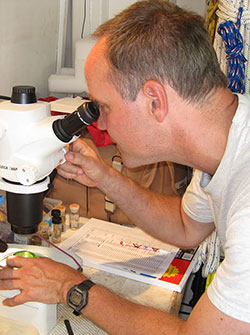
Scott Godwin, Resource Protection Program Specialist
Papahānaumokuākea Marine National Monument
Scott began his career at the Smithsonian Institution conducting research projects focused on marine alien species and how they are transported by human activities. There he also was trained in marine invertebrate taxonomy. He came to Hawaiʻi in 1997 to work as marine biologist for the Bishop Museum in Honolulu, where he continued his work on marine alien species and managed the marine invertebrate collections. Scott has been working in the NWHI since 1999 as a marine invertebrate zoologist and has documented the diversity and abundance of non-coral invertebrates in the region through collaborations with the local Hawaiian scientific community and researchers from around the globe. His research focuses on inventorying marine alien species and how they are introduced to the Hawaiian Archipelago. Scott currently oversees the Resource Protection Program for PMNM, dealing with the response and planning for threats to marine resources in the Monument, such as marine alien species, vessel groundings, oil spills, natural disasters and marine debris. He has been the principal investigator and lead taxonomist on the inventory of established marine alien species within the NWHI since 2009, and is the Chief Scientist of the 2014 RAMP expedition.
Papahānaumokuākea Marine National Monument
Scott began his career at the Smithsonian Institution conducting research projects focused on marine alien species and how they are transported by human activities. There he also was trained in marine invertebrate taxonomy. He came to Hawaiʻi in 1997 to work as marine biologist for the Bishop Museum in Honolulu, where he continued his work on marine alien species and managed the marine invertebrate collections. Scott has been working in the NWHI since 1999 as a marine invertebrate zoologist and has documented the diversity and abundance of non-coral invertebrates in the region through collaborations with the local Hawaiian scientific community and researchers from around the globe. His research focuses on inventorying marine alien species and how they are introduced to the Hawaiian Archipelago. Scott currently oversees the Resource Protection Program for PMNM, dealing with the response and planning for threats to marine resources in the Monument, such as marine alien species, vessel groundings, oil spills, natural disasters and marine debris. He has been the principal investigator and lead taxonomist on the inventory of established marine alien species within the NWHI since 2009, and is the Chief Scientist of the 2014 RAMP expedition.
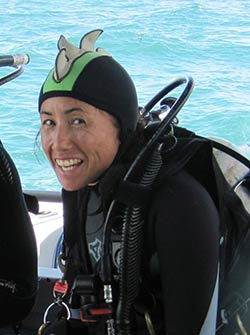
Paula Ayotte, Marine Ecosystem Research Specialist
Coral Reef Ecosystem Division (CRED), Pacific Islands Fisheries Science Center
Paula, as part of CRED’s Rapid Ecological Assessment (REA) fish team, has helped develop fish survey methods training materials and has participated as an REA fish diver or fish team lead on more than 25 RAMP cruises throughout the Pacific during the past seven years; this will be her seventh visit to Papahānaumokuākea Marine National Monument. During this cruise, she will again be leading the fish team in gathering
Coral Reef Ecosystem Division (CRED), Pacific Islands Fisheries Science Center
Paula, as part of CRED’s Rapid Ecological Assessment (REA) fish team, has helped develop fish survey methods training materials and has participated as an REA fish diver or fish team lead on more than 25 RAMP cruises throughout the Pacific during the past seven years; this will be her seventh visit to Papahānaumokuākea Marine National Monument. During this cruise, she will again be leading the fish team in gathering
abcdefghijklmnopqrstuvwxyzabcdefghijklmnopqrstuvwxyzabcdefghijklmnoabcdefghijklmnopqrstuvwxyzabcdefghijklmnopqrstuvwxyzabcdefghijklmnodata to characterize fish populations and benthic composition, as well as torturing her fellow scientists and crew members with her 8-minute ab workout.
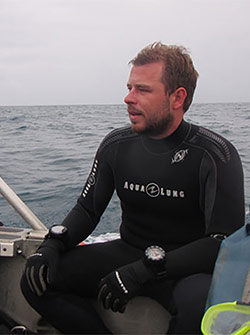
John Burns, Ph.D. Candidate
University of Hawaiʻi-Mānoa Hawaiʻi Institute of Marine Biology
John is a Ph.D. candidate at the University of Hawaiʻi at Mānoa, working with Dr. Ruth Gates at the Hawaiʻi Institute of Marine Biology (HIMB). With expertise is coral biology and coral disease, he has joined several previous RAMP expeditions to examine the health and structure of coral communities throughout the NWHI. John’s research goals are to better understand coral health, as well as the relationship between coral community structure and overall ecosystem functionality. He hopes the data from this work can be used to support conservation efforts aimed at preserving the valuable marine ecosystems within PMNM. To learn more about the work John and others are conducting to study corals, please visit the Coral Health Atlas (http://coralhealth.spatial.hawaii.edu). This interactive website provides imagery, data and information about corals and coral health throughout the Hawaiian Archipelago.
University of Hawaiʻi-Mānoa Hawaiʻi Institute of Marine Biology
John is a Ph.D. candidate at the University of Hawaiʻi at Mānoa, working with Dr. Ruth Gates at the Hawaiʻi Institute of Marine Biology (HIMB). With expertise is coral biology and coral disease, he has joined several previous RAMP expeditions to examine the health and structure of coral communities throughout the NWHI. John’s research goals are to better understand coral health, as well as the relationship between coral community structure and overall ecosystem functionality. He hopes the data from this work can be used to support conservation efforts aimed at preserving the valuable marine ecosystems within PMNM. To learn more about the work John and others are conducting to study corals, please visit the Coral Health Atlas (http://coralhealth.spatial.hawaii.edu). This interactive website provides imagery, data and information about corals and coral health throughout the Hawaiian Archipelago.
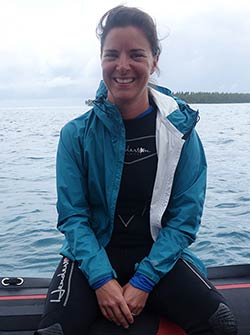
Courtney Couch, Postdoctoral Researcher
Hawaiʻi Institute of Marine Biology
Courtney is a coral disease ecologist and epidemiologist working with PMNM and The Nature Conservancy to better understand how ecological processes and environmental change govern coral disease risk. As part of her postdoctoral research, Courtney is expanding and standardizing coral health and disease monitoring across a number of Big Ocean sites (such as PMNM). Courtney and her team member John Burns will be building on earlier coral disease research in the
Hawaiʻi Institute of Marine Biology
Courtney is a coral disease ecologist and epidemiologist working with PMNM and The Nature Conservancy to better understand how ecological processes and environmental change govern coral disease risk. As part of her postdoctoral research, Courtney is expanding and standardizing coral health and disease monitoring across a number of Big Ocean sites (such as PMNM). Courtney and her team member John Burns will be building on earlier coral disease research in the
abcdefghijklmnopqrstuvwxyzabcdefghijklmnopqrstuvwxyzabcdefghijklmnoabcdefghijklmnopqrstuvwxyzabcdefghijklmnopqrstuvwxyzabcdefghijklmnoabcdefghijklmnopqrstuvwxyzabcdefghijklmnoabcdefghijklmnopqrstuvwxyzabcdefghijklmnoMonument by assessing the patterns in coral health and disease and identifying new disease hot spots. They will also reassess prior monitoring sites and establish new long-term sites to determine how coral health is changing over time in highly sensitive coral populations. Ultimately, through her work in the Monument and other regions in the Indo-Pacific, Courtney is building capacity and facilitating communication between marine resource managers and scientists to better integrate coral health into reef resilience planning. After more than five years of coral disease research in the Main Hawaiian Islands, Courtney will be making her first voyage to the Monument on this trip.
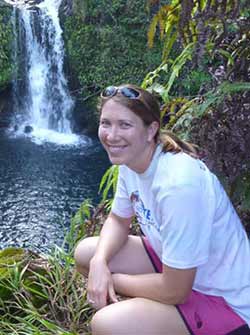
Chelsie Counsell, Graduate Student Researcher
Hawaiʻi Institute of Marine Biology
Chelsie is a first year University of Hawaiʻi graduate student whose research is focused on community dynamics – mainly patterns of connectivity and strength of species interactions – within reef ecosystems. On this expedition, she will be surveying the semi-cryptic fish and invertebrate communities that live within cauliflower corals (Pocillopora meandrina) at multiple sites to analyze patterns in community composition.
Hawaiʻi Institute of Marine Biology
Chelsie is a first year University of Hawaiʻi graduate student whose research is focused on community dynamics – mainly patterns of connectivity and strength of species interactions – within reef ecosystems. On this expedition, she will be surveying the semi-cryptic fish and invertebrate communities that live within cauliflower corals (Pocillopora meandrina) at multiple sites to analyze patterns in community composition.
abcdefghijklmnopqrstuvwxyzabcdefghijklmnopqrstuvwxyzabcdefghijklmnoabcdefghijklmnopqrstuvwxyzabcdefghijklmnopqrstuvwxyzabcdefghijklmnoabcdefghijklmnopqrstuvwxyzabcdefghijkChelsie will be collecting tissue samples from scorpionfish and trapezid crabs to determine population connectivity around an atoll as well as between multiple atolls. She will also be assisting with ongoing coral reef bioerosion and shark tracking research. This is Chelsie’s first expedition to the Monument.
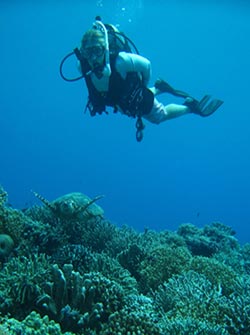
Emily Gaskin, Policy Specialist
Hawaiian Islands Humpback Whale National Marine Sanctuary
Emily oversees the development and implementation of policies and regulations for the Hawaiian Islands Humpback Whale National Marine Sanctuary. Prior to working in Hawaiʻi, she spent five years working at the National Marine Sanctuary of American Samoa (formerly the Fagatele Bay National Marine Sanctuary). With an academic background in Environmental Economics, Emily will be applying her passion for numbers to her position as Data Manager on the expedition. Emily has previously travelled to several remote islands in the South Pacific and Western Pacific, but this is her first expedition to the Monument. She looks forward to visiting Midway where her grandfather worked for many years as a submarine technician.
Hawaiian Islands Humpback Whale National Marine Sanctuary
Emily oversees the development and implementation of policies and regulations for the Hawaiian Islands Humpback Whale National Marine Sanctuary. Prior to working in Hawaiʻi, she spent five years working at the National Marine Sanctuary of American Samoa (formerly the Fagatele Bay National Marine Sanctuary). With an academic background in Environmental Economics, Emily will be applying her passion for numbers to her position as Data Manager on the expedition. Emily has previously travelled to several remote islands in the South Pacific and Western Pacific, but this is her first expedition to the Monument. She looks forward to visiting Midway where her grandfather worked for many years as a submarine technician.
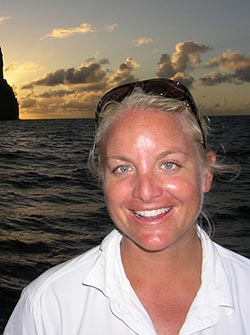
Kelly Gleason, Maritime Heritage Coordinator
Papahānaumokuākea Marine National Monument
Kelly began working for the Office of National Marine Sanctuaries in Honolulu in 2004 as part of the Pacific Islands Region, and became the Maritime Heritage Coordinator for PMNM in the fall of 2007. Kelly’s work involves the exploration, interpretation and protection of maritime heritage resources in the NWHI. These resources include at least 60 potential shipwreck sites and 70 potential sunken aircraft sites; to date, 22 of these sites have been discovered and documented.
Papahānaumokuākea Marine National Monument
Kelly began working for the Office of National Marine Sanctuaries in Honolulu in 2004 as part of the Pacific Islands Region, and became the Maritime Heritage Coordinator for PMNM in the fall of 2007. Kelly’s work involves the exploration, interpretation and protection of maritime heritage resources in the NWHI. These resources include at least 60 potential shipwreck sites and 70 potential sunken aircraft sites; to date, 22 of these sites have been discovered and documented.
abcdefghijklmnopqrstuvwxyzabcdefghijklmnopqrstuvwxyzabcdefghijklmnoabcdefghijklmnopqrstuvwxyzabcdefghijklmnopqrstuvwxyzabcdefghijklmnoRecent discoveries include the Nantucket whaleship Two Brothers and a Brewster F2A-3 Buffalo aircraft at Midway Atoll. In addition to field and academic research, Kelly’s work includes education and outreach, having developed and installed two PMNM maritime heritage themed exhibits (one in Hilo, HI and one in Nantucket, MA), produced two short documentary films on maritime heritage in PMNM, and has made countless presentations at conferences and classrooms. Kelly has also worked on shipwreck sites in Scotland, North Carolina, Northern California, Washington, the Great Lakes and the Caribbean. Kelly is a mixed gas technical diver and one of only a handful of Level III closed circuit rebreather divers, participating in exploratory research expeditions to characterize the mesophotic (deep) reef zone in the Monument. This is Kelly’s xx trip to PMNM, during which she will be conducting surveys of maritime archaeology sites.
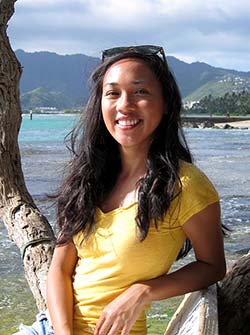
Tiffany Nicole (Nikki) Gutlay, Marine Biology Graduate
University of Hawaiʻi at Mānoa
Nikki is a recent graduate (2013) of University of Hawaiʻi at Mānoa where she obtained a B.S. in Marine Biology. Earlier this year, she presented a research poster studying the effects of coral size on the abundance and diversity of fishes and invertebrates in Kāneʻohe Bay at the Albert L. Tester Symposium. Currently, Nikki volunteers as a scientific diver for the Donahue Lab at the Hawaiʻi Institute of Marine Biology. She intends on pursuing a graduate degree to further her interests in coral reef ecology. She is joining the RAMP expedition as a scientific diver conducting fish and benthic surveys. This will be her first time to the Monument and participating in a research cruise.
University of Hawaiʻi at Mānoa
Nikki is a recent graduate (2013) of University of Hawaiʻi at Mānoa where she obtained a B.S. in Marine Biology. Earlier this year, she presented a research poster studying the effects of coral size on the abundance and diversity of fishes and invertebrates in Kāneʻohe Bay at the Albert L. Tester Symposium. Currently, Nikki volunteers as a scientific diver for the Donahue Lab at the Hawaiʻi Institute of Marine Biology. She intends on pursuing a graduate degree to further her interests in coral reef ecology. She is joining the RAMP expedition as a scientific diver conducting fish and benthic surveys. This will be her first time to the Monument and participating in a research cruise.
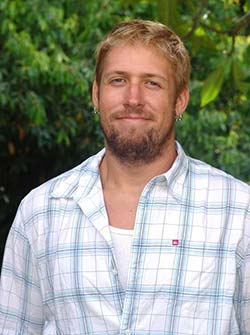
Kevin Lino, Marine Ecosystems Research Coordinator
Joint Institute for Marine and Atmospheric Research (JIMAR)/NOAA
Kevin is a Marine Ecosystems Research Coordinator for NOAA through the Pacific Islands Fisheries Science Center’s (PIFSC) Coral Reef Ecosystems Division (CRED). Kevin is a dive master and boat instructor who coordinates and organizes logistics for his division’s various field surveys throughout the Pacific. Kevin is a seasoned fish researcher who will be conducting fish survey dives and be a coxswain for the small
Joint Institute for Marine and Atmospheric Research (JIMAR)/NOAA
Kevin is a Marine Ecosystems Research Coordinator for NOAA through the Pacific Islands Fisheries Science Center’s (PIFSC) Coral Reef Ecosystems Division (CRED). Kevin is a dive master and boat instructor who coordinates and organizes logistics for his division’s various field surveys throughout the Pacific. Kevin is a seasoned fish researcher who will be conducting fish survey dives and be a coxswain for the small
abcdefghijklmnopqrstuvwxyzabcdefghijklmnopqrstuvwxyzabcdefghijklmnoabcdefghijklmnopqrstuvwxyzabcdefghijklmnopqrstuvwxyzabcdefghijklmnoabcdefghijklmnopqrstuvwxyzabcdefghijklmnoboats during the cruise. His first time to the NWHI was in 2005 with a marine debris removal team. Kevin has returned to the Monument a dozen times since then on several different missions. He is looking forward to hopefully seeing his favorite endemic Hawaiian fish species, the Hawaiian Morwong (Goniistius vittatus).
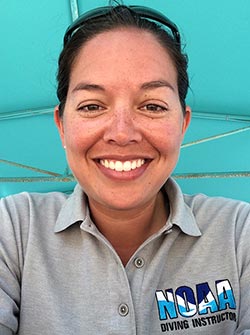
Katie Mahaffey, Program Support Specialist
NOAA Dive Center
Katie spent years diving off the coast of the Pacific Northwest and has trained as an Air and Mixed Gas Surfaced Supplied Diver, specializing in underwater welding and salvage. Now, as a NOAA working diver, Level I Closed Circuit Rebreather Diver, Dive Master, Dive Medical Technician and Instructor with the NOAA Diving Center, she trains new NOAA divers. On this expedition, she is diving with the science dive team as a dive master and chamber supervisor.
NOAA Dive Center
Katie spent years diving off the coast of the Pacific Northwest and has trained as an Air and Mixed Gas Surfaced Supplied Diver, specializing in underwater welding and salvage. Now, as a NOAA working diver, Level I Closed Circuit Rebreather Diver, Dive Master, Dive Medical Technician and Instructor with the NOAA Diving Center, she trains new NOAA divers. On this expedition, she is diving with the science dive team as a dive master and chamber supervisor.
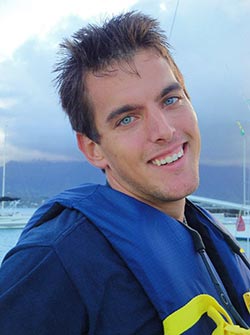
Stephen Matadobra, Marine Biology Student
University of Hawaiʻi at Mānoa
Stephen is an undergraduate student finishing up a degree in Marine Biology and a Marine Option Certificate at the University of Hawaiʻi at Mānoa. John is training to become a diver medical technician and is currently working at the John A. Burns School of Medicine hyperbaric treatment center. Earlier this year, Stephen helped trace a sunken shark heiau (cultural heritage site ) in Pelekane Bay while taking a field archaeology
University of Hawaiʻi at Mānoa
Stephen is an undergraduate student finishing up a degree in Marine Biology and a Marine Option Certificate at the University of Hawaiʻi at Mānoa. John is training to become a diver medical technician and is currently working at the John A. Burns School of Medicine hyperbaric treatment center. Earlier this year, Stephen helped trace a sunken shark heiau (cultural heritage site ) in Pelekane Bay while taking a field archaeology
abcdefghijklmnopqrstuvwxyzabcdefghijklmnopqrstuvwxyzabcdefghijklmnoabcdefghijklmnopqrstuvwxyzabcdefghijklmnopqrstuvwxyzabcdefghijklmnocourse on the Big Island of Hawai‘i. He will be participating on this year’s RAMP expedition as a scientific diver, conducting fish and benthic surveys. This is Stephen’s first time to the Monument.
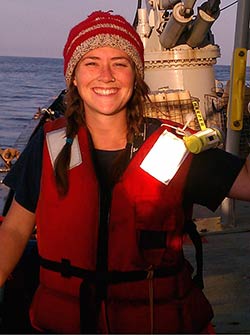
Eileen Nalley, Marine Biology Student
University of Hawaiʻi at Mānoa
Eileen is starting her second year of the Marine Biology Graduate Program at the University of Hawaiʻi at Mānoa, and is studying shifting functional roles in Hawaiian reef fish. Through the application of molecular techniques to diet studies, she hopes to better understand how generalists respond to anthropogenic impacts and increased algal cover. On this expedition, Eileen will be working as a Scientific Diver as part of a research team from the University of Hawaiʻi studying the communities within cauliflower corals (Pocillopora meandrina), examining bioerosion in the Monument, and retrieving receivers used to track reef predators. This is Eileen’s first expedition to the Monument.
University of Hawaiʻi at Mānoa
Eileen is starting her second year of the Marine Biology Graduate Program at the University of Hawaiʻi at Mānoa, and is studying shifting functional roles in Hawaiian reef fish. Through the application of molecular techniques to diet studies, she hopes to better understand how generalists respond to anthropogenic impacts and increased algal cover. On this expedition, Eileen will be working as a Scientific Diver as part of a research team from the University of Hawaiʻi studying the communities within cauliflower corals (Pocillopora meandrina), examining bioerosion in the Monument, and retrieving receivers used to track reef predators. This is Eileen’s first expedition to the Monument.
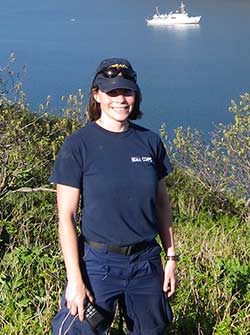
ENS Hadley A Owen, Vessel Operations Coordinator
Papahānaumokuākea Marine National Monument
Hadley has been a NOAA Corps Commissioned Officer since 2012, working in Alaska and the Pacific Northwest before joining up with the Monument this past May. Her responsibilities include maintenance and operation of the Monument’s four small boats. This is her first time in the Monument joining the RAMP expedition, for which she will be serving as coxswain and providing dive support for the research teams.
Papahānaumokuākea Marine National Monument
Hadley has been a NOAA Corps Commissioned Officer since 2012, working in Alaska and the Pacific Northwest before joining up with the Monument this past May. Her responsibilities include maintenance and operation of the Monument’s four small boats. This is her first time in the Monument joining the RAMP expedition, for which she will be serving as coxswain and providing dive support for the research teams.
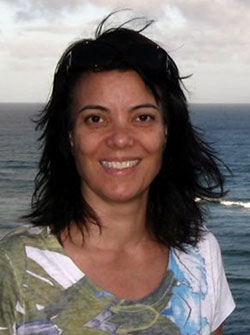
Toni Parras, Communications Manager
Papahānaumokuākea Marine National Monument
Toni coordinates the Monument’s media/public affairs efforts, develops outreach campaigns, activities and materials, and oversees the Monument website. She is joining the RAMP expedition to document research activities and produce content to share with a variety of audiences – including Monument staff, partners and co-managers, students and teachers, and the broader public. During the cruise, Toni will interview scientists and accompany them during their research to gather stories and photographs for disseminating widely, facilitate a ship-to-studio radio show with scientists on board, conduct ship-to-classroom “ask a scientist” sessions, maintain an expedition log on the PMNM website, prepare content for posting on the PMNM Facebook page, Twitter and Flickr sites, and develop a post-cruise story for media release. Toni has conducted fieldwork throughout the Bahamas, Caribbean, South and Central America, the Philippines, Papua New Guinea and Fiji. She has previously been to Midway Atoll for a brief visit, but this is her first ship-based expedition to the Monument.
Papahānaumokuākea Marine National Monument
Toni coordinates the Monument’s media/public affairs efforts, develops outreach campaigns, activities and materials, and oversees the Monument website. She is joining the RAMP expedition to document research activities and produce content to share with a variety of audiences – including Monument staff, partners and co-managers, students and teachers, and the broader public. During the cruise, Toni will interview scientists and accompany them during their research to gather stories and photographs for disseminating widely, facilitate a ship-to-studio radio show with scientists on board, conduct ship-to-classroom “ask a scientist” sessions, maintain an expedition log on the PMNM website, prepare content for posting on the PMNM Facebook page, Twitter and Flickr sites, and develop a post-cruise story for media release. Toni has conducted fieldwork throughout the Bahamas, Caribbean, South and Central America, the Philippines, Papua New Guinea and Fiji. She has previously been to Midway Atoll for a brief visit, but this is her first ship-based expedition to the Monument.
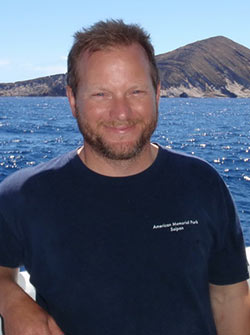
Jason Raupp, Maritime Archaeologist
Flinders University
Jason is a Ph.D. Candidate and Research Fellow in the Department of Archaeology at Flinders University in South Australia. His dissertation research focuses on early nineteenth century pelagic whaling and the industrial aspects of two American whaleships wrecked in the Monument. Joining this year’s RAMP expedition as a member of the Maritime Heritage Team, Jason’s role will be to assist with archeological surveys, site recording and data analysis. This is Jason’s fourth research voyage to the Monument.
Flinders University
Jason is a Ph.D. Candidate and Research Fellow in the Department of Archaeology at Flinders University in South Australia. His dissertation research focuses on early nineteenth century pelagic whaling and the industrial aspects of two American whaleships wrecked in the Monument. Joining this year’s RAMP expedition as a member of the Maritime Heritage Team, Jason’s role will be to assist with archeological surveys, site recording and data analysis. This is Jason’s fourth research voyage to the Monument.
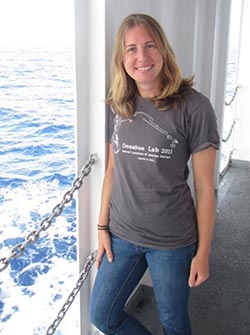
Nyssa Silbiger, Ph.D. Candidate and NOAA Dr. Nancy Foster Scholar
Hawaiʻi Institute of Marine Biology
Nyssa is examining how natural environmental variability and human-induced environmental change (i.e., climate change) influence bioerosion rates on Hawaiian coral reefs. She will be assisting with three field projects during this expedition: collecting samples to measure reef bioerosion rates and describe the bioeroder community (tiny invertebrates that naturally break-down the reef structure), examining how species interact in cauliflower (Pocillopora sp) coral heads, and retrieving data receivers for the pelagics lab at Hawaiʻi Institute of Marine Biology that were placed on a previous mission to track reef predator migration patterns. This is Nyssa’s fourth cruise to the Monument. She hopes that the data collected on these expeditions can help us to better understand how corals reefs are responding to a rapidly changing climate.
Hawaiʻi Institute of Marine Biology
Nyssa is examining how natural environmental variability and human-induced environmental change (i.e., climate change) influence bioerosion rates on Hawaiian coral reefs. She will be assisting with three field projects during this expedition: collecting samples to measure reef bioerosion rates and describe the bioeroder community (tiny invertebrates that naturally break-down the reef structure), examining how species interact in cauliflower (Pocillopora sp) coral heads, and retrieving data receivers for the pelagics lab at Hawaiʻi Institute of Marine Biology that were placed on a previous mission to track reef predator migration patterns. This is Nyssa’s fourth cruise to the Monument. She hopes that the data collected on these expeditions can help us to better understand how corals reefs are responding to a rapidly changing climate.
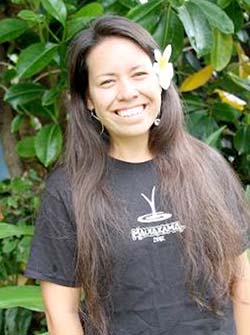
Kanoelani Steward, Marine Science and Hawaiian Studies Student
University of Hawaiʻi at Hilo
Kanoelani, originally from Lahaina, Maui, is an undergraduate senior at the University of Hawaiʻi at Hilo majoring in Marine Science and Hawaiian Studies. Kanoe is a member of Youth Service Hawaiʻi, where she incorporates what she is learning in college into her services in the community. She will be participating on this year’s RAMP expedition as a scientific diver, conducting coral surveys with the science team. This is Kanoe’s first time to the Monument.
University of Hawaiʻi at Hilo
Kanoelani, originally from Lahaina, Maui, is an undergraduate senior at the University of Hawaiʻi at Hilo majoring in Marine Science and Hawaiian Studies. Kanoe is a member of Youth Service Hawaiʻi, where she incorporates what she is learning in college into her services in the community. She will be participating on this year’s RAMP expedition as a scientific diver, conducting coral surveys with the science team. This is Kanoe’s first time to the Monument.
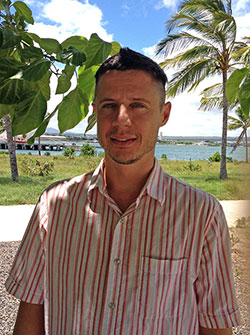
Nick Tenney, Senior Information Technology Specialist
Papahānaumokuākea Marine National Monument
Nick manages and maintains the network and computing infrastructure for the Monument. An avid waterman, he will be participating as a maritime archeological research assistant on this expedition, assisting researchers with snorkel, dive and data management operations. This is Nick’s first visit to the Monument and he is very excited to be part of the 2014 RAMP cruise.
Papahānaumokuākea Marine National Monument
Nick manages and maintains the network and computing infrastructure for the Monument. An avid waterman, he will be participating as a maritime archeological research assistant on this expedition, assisting researchers with snorkel, dive and data management operations. This is Nick’s first visit to the Monument and he is very excited to be part of the 2014 RAMP cruise.
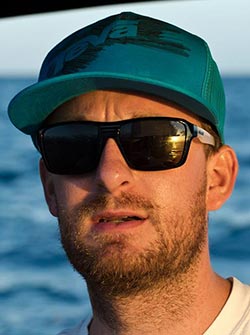
Tate Wester, Marine Biology Student
University of Hawaiʻi at Mānoa
Tate is an undergraduate at the University of Hawaiʻi-Mānoa Marine Biology Program. He is the student coordinator for UH’s Marine Option Program, for which he organizes marine related field trips and activities and assists with the scientific diving field schools. Tate also works at the Kuakini Hyperbaric Treatment Center as a care provider, going on dives in the hyperbaric chamber to attend to patients. Tate plans to pursue a Master’s Degree at the University of Hawaiʻi studying the fish communities associated with artificial reefs, shipwrecks and submerged cultural heritage sites in Hawaiʻi to determine the ecological roles of these structures. For this expedition, Tate will be a scientific diver on the fish team researching the differences in fish species composition between the Main and Northwestern Hawaiian Islands. This will be Tate’s first time to the Monument.
University of Hawaiʻi at Mānoa
Tate is an undergraduate at the University of Hawaiʻi-Mānoa Marine Biology Program. He is the student coordinator for UH’s Marine Option Program, for which he organizes marine related field trips and activities and assists with the scientific diving field schools. Tate also works at the Kuakini Hyperbaric Treatment Center as a care provider, going on dives in the hyperbaric chamber to attend to patients. Tate plans to pursue a Master’s Degree at the University of Hawaiʻi studying the fish communities associated with artificial reefs, shipwrecks and submerged cultural heritage sites in Hawaiʻi to determine the ecological roles of these structures. For this expedition, Tate will be a scientific diver on the fish team researching the differences in fish species composition between the Main and Northwestern Hawaiian Islands. This will be Tate’s first time to the Monument.
Return to RAMP Expedition Log.
